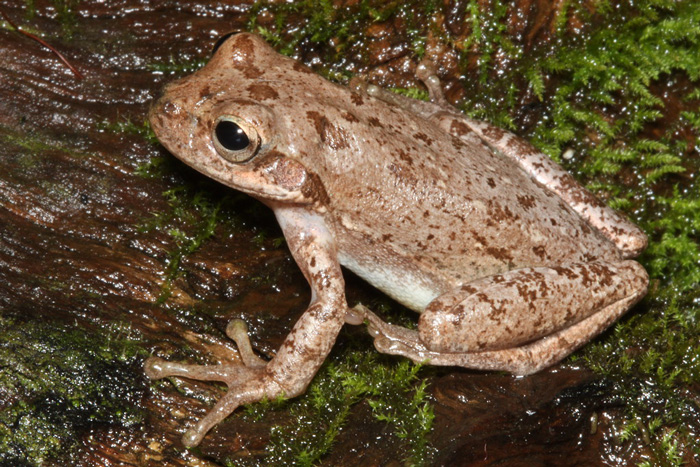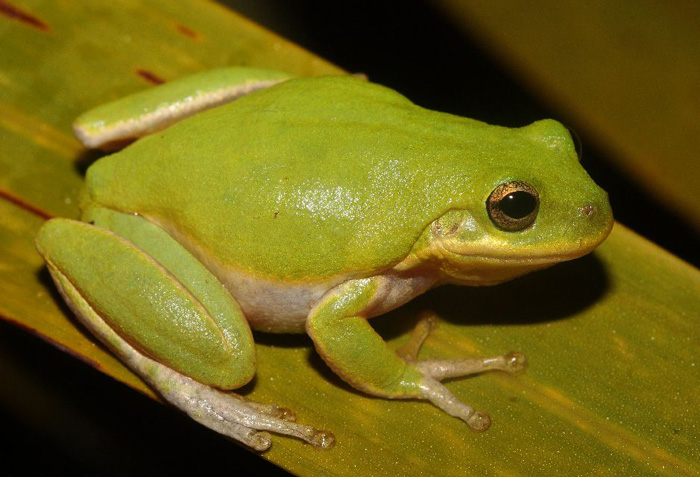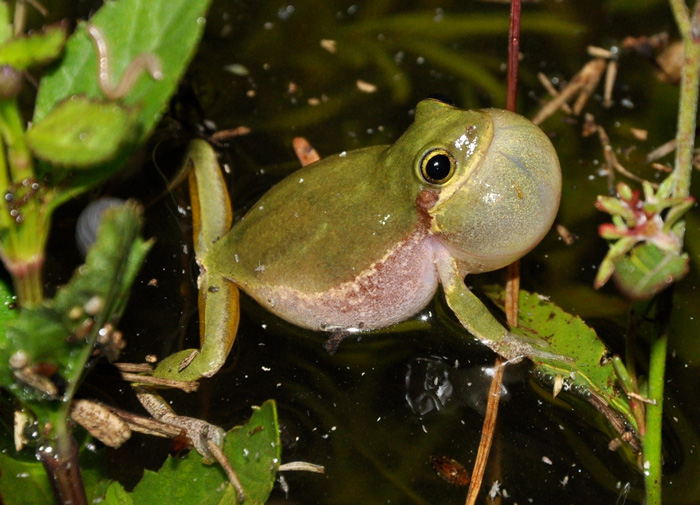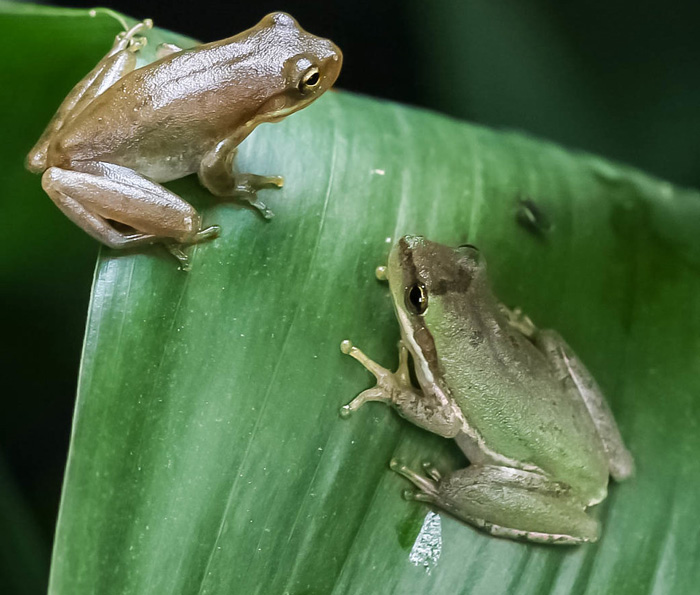The Squirrel Tree Frog, scientifically known as Hyla squirella, is a small, colorful amphibian. This frog is native to the southeastern United States. Although they go by the name “squirrels,” they are essentially tree-dwelling frogs with distinctive sounds and acrobatic skills.
The Squirrel Tree Frog belongs to the family Hylidae, genus Hyla, and species squirella. They are well renowned for their bright green hue and sticky toe pads, which enable them to climb trees.
These unique frogs help to regulate bug populations and provide food for larger predators. To keep the balance of our ecology, it is essential to research and conserve the Squirrel Tree Frog population.
In this article, we’ll cover the physical characteristics, habitat, behavior, frog ecology, mating habits, and threats squirrel tree frogs face in the wild. Keep reading and learn the unknown.
Scientific Classification

Before going deep with the factors of squirrel tree frog, first let us know its scientific classification.
| Common name | Squirrel Treefrog |
| Scientific name | Dryophytes squirellus |
| Kingdom | Animalia |
| Phylum | Chordata |
| Class | Amphibia |
| Order | Anura |
| Family | Hylidae |
| Genus | Dryophytes |
| Species | D. squirellus |
What Physical Characteristics Set Squirrel Tree Frogs Apart From Other Amphibians?

Squirrel Tree Frogs’ physical characteristics are unique and impressive. You can tell them apart from other frog species by spotting the distinctive characteristics listed in the table below.
| Physical traits | Description |
|---|---|
| Skin Texture | Squirrel Tree Frogs have soft, moist skin. |
| Color of the Eyes | They have big and ova eyes with golden or bronze pupils. |
| Toe Pads | Squirrel Tree Frogs have sticky pads on their toes that allow them to cling to rocks and trees. |
| Size | The average length of an adult squirrel tree frog is about 1-1.5 inches. |
| Color of Squirrel Tree Frogs | They have a white or cream-colored underside side and a green or brown dorsal side with darker patterns. |
| Weight | They are generally 0.1 to 0.2 ounces. |
| Body shape | They have a round body shape and long, slender legs adapted for climbing and jumping. |
| Vocalization | During the breeding season, male Squirrel Tree Frogs emit high-pitched sounds and cries. |
What adaptation strategies squirrel tree frogs have developed to survive?

Squirrel Tree Frogs have several adaptations that enable them to survive in their forest habitats. Some of the adaptation techniques are listed below.
- They have adopted an arboreal lifestyle to protect themselves against ground-based predators and spend most of their time in trees.
- Squirrel tree frogs are nocturnal animals. They are active on the nights when it is cooler outside, and there is less rivalry over food.
- Squirrel tree frogs have specialized skin that helps them retain moisture, which is important for survival in dry environments.
- The green or brownish coloring of squirrel tree frogs helps them blend in with the leaves and bark of trees, making them hard to notice by predators.
- These frogs have adapted to climb trees, which helps them avoid predators and locate food.
- Squirrel tree frogs hibernate in tree branches or under leaves to conserve energy and withstand the cold winter months.
What are the different species of Squirrel Tree Frogs?

The world is home to a number of different species of Squirrel Tree Frogs. To learn more about the several species of Squirrel Tree Frogs, see the table below.
| Name of Species | Typically found in | Description |
|---|---|---|
| Barking Tree Frog | Southeastern United States | They are huge, typically green, and have warty skin. They got this unique name due to their loud “woof-woof” call. |
| White-lipped Squirrel Tree Frog | Eastern Africa | They are green and medium-sized frogs. They have a distinct white stripe over their top lip. |
| Cuban Squirrel Tree Frog | The Bahamas and the Cayman Islands | These frogs are large, usually grayish or brown, and have an eye stripe that makes them stand out. |
| Pine-woods Tree Frogs | Southeastern United States | The Pinewoods Treefrog is a small to medium-sized frog and sports vivid yellow markings on the inner thigh. |
What Are Some Of The Key Behaviors and Habitats Exhibited By Squirrel Tree Frogs?
Squirrel Tree Frogs exhibit a range of behaviors to survive and thrive in their natural frog habitats. I have outlined some of the main Squirrel Tree Frog behaviors for you below.

Activity Patterns
Being largely nocturnal, Squirrel Tree Frogs are most active at night. They often take refuge throughout the day in tree trunks, under the leaves, or in other cool places to escape the heat and potential predators.
Interaction Techniques
Squirrel Tree Frogs are known for their vocalizations, which are high-pitched chirps that can be heard from a distance. They can communicate with other frogs through their body language. This includes how their legs are positioned and the color of their skin.
Predators and Protective Measures
There are numerous predators of Squirrel Tree Frogs, such as birds, snakes, and larger frogs. They have a variety of protective measures, including
- As a kind of defense, some species, like the Cuban Squirrel Tree Frog, may also secrete toxins from their skin.
- To distract and scare predators, they also make loud chirping or squirrel-like noises.
- One of the most significant predator-prey interactions for the squirrel tree frog is with snakes. The squirrel tree frog may attempt to escape a snake attack by jumping or climbing away.
Locomotion
These frogs can climb quite well thanks to their well-developed climbing abilities and sticky toe pads. They also have a habit of diving into the water to avoid predators.
Social structure
Squirrel tree frogs are essentially solitary creatures that exhibit a minimal degree of socialism. Most of their interactions are centered around reproduction and communication.
Where Can You Typically Locate Squirrel Tree Frogs?

Squirrel Tree Frogs commonly inhabit forest ecosystems in the lower Piedmont and Coastal Plain regions of the southeast United States. The following table discusses the Squirrel Tree Frog habitat and their geographical distribution.
| Feature | Description |
|---|---|
| Frog Habitat | They reside close to vegetation-rich lakes, ponds, streams, and wetlands |
| Climate | Squirrel Tree Frogs are adaptable to climate change, but they prefer a humid environment |
| Geographic location | Southeastern United States, from North Carolina to Florida and Louisiana |
What Are The Mating Habits Of Squirrel Tree Frogs?

The mating habits of Squirrel Tree Frogs play an important role in their reproductive biology and are a fascinating example of the diversity of animal behavior. Squirrel Tree Frogs typically reach sexual maturity between the ages of one and two.
- Matting season: Squirrel tree frogs mate during the spring and early summer months, typically from March to August. Male squirrel tree frogs will gather close to water features, such as shallow ponds or streams, during the breeding season. Then they’ll start making unique sounds to attract potential mates.
- Egg-laying habit: Once a female has joined a male, the two will engage in amplexus. As the female deposits her eggs in the water, the male will release sperm to fertilize the eggs. Female squirrel tree frogs can lay anywhere from a few dozen to a thousand eggs all at once.
- Parental care: Squirrel tree frogs do not exhibit any parental care. After the eggs are laid, the male and female will let them grow on their own. In approximately a week, these eggs will grow into tadpoles, which will eventually develop legs and lungs and transition into adults.
The Diet of Squirrel Tree Frogs: The Things You Need to Know.

Being predominantly insectivorous, Squirrel Tree Frogs consume a lot of insects in their diet. They eat a variety of tiny invertebrates, such as-
- Ants
- Flies
- Crickets
- Grasshoppers
- Moths
- Beetles
Nonetheless, these frogs may consume any available food, even non-insect things like small snails, spiders, and woodlice, during food shortages. They occasionally have been observed consuming other little frogs, although this is not a significant portion of their diet.
According to a study, Squirrel Tree Frogs have been seen using a range of foraging tactics, including actively seeking their prey, waiting for prey to approach them, and hovering over shallow ponds or foliage to snare it.
What Threats Do Squirrel Tree Frogs Encounter To Survive?

According to the IUCN Red List, squirrel tree frogs now have a conservation status of “Least Concern.” This implies that there is no immediate threat to their extinction. They do, however, face several threats to their population. The typical threats that Squirrel Tree Frogs encounter in the wild are listed below.
- Habitat loss: Due to human activities like deforestation, logging, urbanization, and infrastructure development, squirrel tree frogs are known to experience habitat fragmentation and a shortage of food.
- Pet Trade: The survival rate of squirrel tree frogs may be harmed by the practice of collecting them for the pet trade.
- Pollution: Chemical pollution from pesticides, herbicides, and other substances can taint the water and soil that are vital to squirrel tree frogs. This may result in increased susceptibility to diseases and infertility.
- Climate change: The mating and population rate of Squirrel tree frogs can be significantly impacted by climate change, flooding, and droughts.
What Conservation Measures Are Being Taken To Save The Squirrel Tree Frog Population?
We must undertake continuous conservation efforts to ensure the survival of Squirrel Tree Frogs and other species in the forest ecosystem. According to researchers, at least 43% of the 7,164+ amphibian species are deteriorating, and about 32% of them are currently in danger of going extinct.
Therefore, using efficient Squirrel Tree Frog conservation techniques is crucial to preserve their dwindling population. Particularly, the Squirrel Tree Frog is an indicator species, meaning that its existence or absence might reveal the condition of the ecosystem.

If the number of Squirrel Tree Frogs decreases, it can be a sign that the forest ecosystem is experiencing an underlying issue like pollution, habitat loss, or climate change.
Here are some of the frog conservation methods:
- Pollution control: Contamination of air and water can lead to harmful effects on the health of these frogs and their habitat. To address this issue, measures should be taken to reduce environmental pollution.
For instance, research institutions like the University of Georgia Savannah River Ecology Laboratory carry out studies on ways to reduce pollution levels that affect frog survival and health.
This may entail cutting back on the usage of dangerous chemicals and upgrading waste disposal techniques.
- Public education: Educational programs are being developed to raise public awareness about the importance of conserving squirrel tree frogs and their habitats.
- Prevention from diseases: The fungus chytridiomycosis, which according to research, has led to the loss of 90 amphibian species, is one of the primary dangers to the squirrel tree frog population. To prevent the spread of disease, biosecurity measures are implemented.
- Programs for Captive Breeding: Programs for captive breeding entail raising squirrel tree frogs before releasing them into the wild to boost population growth. These initiatives can offer beneficial research opportunities to better understand the behavior of the species.
- Restoration of habitat: Loss of habitat is a significant threat to the squirrel tree frog. We should carry out restoration efforts, such as planting native vegetation and building artificial wetlands, to conserve and restore the frog’s natural habitat.
- Legal protection: Legal protections, including federal and state laws, are important tools in maintaining the populations of Squirrel Tree Frogs and other species.
For instance, in Florida, Squirrel Tree Frogs have been designated as a species of special concern, which offers additional safety and conservation efforts to support the preservation of their populations.
Interesting Facts about Squirrel Tree Frogs

Here is a list of interesting facts about Squirrel Tree Frogs if you wish to learn more about them.
- Squirrel Tree Frogs normally live for three to five years in the wild, but with the right care and proper diet, they can live even longer.
- Squirrel Tree Frogs also engage in aggressive behavior towards other males during mating season.
- Males who produce more energetic calls are more likely to attract females for mating.
- Another fascinating fact about squirrel tree frogs is that females have been seen to exhibit strong attraction to males with particularly noticeable lateral body stripes.
This attraction could be explained by the fact that a male’s genetic makeup or general health can be determined by the size of his stripe.
The squirrel tree frog is a fascinating species of frog known for its arboreal lifestyle and unique adaptations. If you’re interested in learning more about frogs, you might find our guides on tungara frog and wood frogs intriguing as well. Our guide on tungara frog explores their intricate vocalizations and mating behavior, providing insights into their captivating social interactions. Additionally, if you’re curious about frogs that inhabit woodland areas, our guide on wood frogs delves into their characteristics and adaptations for survival in forested environments. By exploring these guides, you’ll gain a better understanding of the diverse frog species and their fascinating behaviorsFinal Words
In conclusion, these little, colorful frogs are signs of a healthy ecosystem and are essential in managing insect populations. Unfortunately, habitat loss and climate change are causing their populations to decline.
Thus, more studies should be done, and conservation activities are required to protect Squirrel Tree Frogs and other species in forest ecosystems. By doing this, we can ensure that these important species continue to thrive and contribute to the health of our planet.

Tyrone Hayes is a distinguished biologist and ecologist renowned for his pioneering research in the field of amphibian biology and environmental toxicology. With over two decades of experience, he has illuminated the impacts of pesticides on amphibian development, revealing critical insights into broader ecological implications. Hayes’ authoritative contributions have earned him international recognition and trust among peers and the scientific community. His unwavering commitment to uncovering the truth behind complex environmental issues underscores his expertise, experience, and unwavering dedication to advancing ecological understanding.
